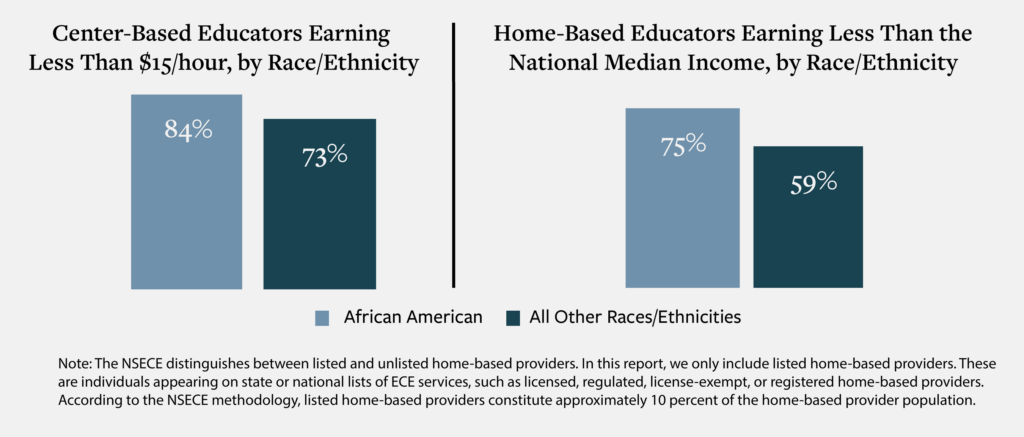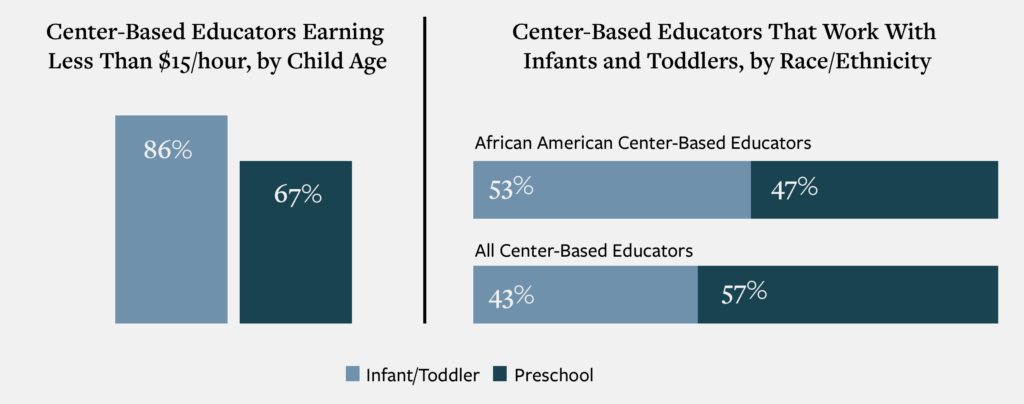The current early education system is built on racial inequities.
Racial wage gaps and limitations to professional opportunities exist for women of color across occupations. Regardless of their job or field, women of color experience the greatest wage gaps when compared to white, non- Hispanic men (Hegewisch, Phil, & Hartmann, 2019). These structural inequities impact not only their immediate circumstances, but establish economic inequalities that follow them into retirement (Hogan & Perrucci, 2007).
The historical and pervasive undervaluing of labor performed by women and minorities in the United States has combined to create one of the most underpaid workforces in the country: those who care for and teach young children. The early care and education (ECE) sector is comprised almost exclusively of women, 40 percent of whom are people of color. These educators represent the most racially diverse sector of the teaching workforce, compared to K-12 and postsecondary education in which nearly three-quarters of educators are white (Taie & Goldring, 2017; NCES, n.d.; Myers, 2016). Early educators are among the lowest-paid workers in every state (Whitebook, McLean, Austin, & Edwards, 2018), which creates especially compromised circumstances for African American and Hispanic women in this profession.
Such economic hardship not only undermines educators’ ability to deliver on the promise of high-quality early care and education, it harms those performing this work and their own families. Additionally, the complex skills and knowledge required of educators to effectively foster the learning and development of young children is at odds with the low status currently accorded to this work.
The average hourly wage of child care workers is $10.72 per hour, and such low wages mean that 53 percent of these workers live in families that utilize public income supports (like the federal Earned Income Tax Credit). This rate is more than double that of workers across all occupations. Preschool teachers fare somewhat better, earning a median hourly wage of $13.94, but they, too, report high utilization of income supports in comparison with other occupations and elementary school teachers (Whitebook, et al., 2018). These national averages provide some insight into the reality of low pay and its consequences, but overcoming long-standing inadequacies in early childhood work- force data collection is essential to unmasking the disparities that exist among early educators and understanding how circumstances vary by state and local context (Whitebook, et al., 2018).
ECE Workforce Data
The Bureau of Labor and Statistics reports information on individual wage earners who self-select into the Census-labeled categories of “child care worker” or “preschool teacher.” The National Survey of Early Care and Education (NSECE), released in 2014, allows for a closer examination of the workforce by more discrete job titles and workplace settings. The NSECE is the most recent comprehensive source of national data. An updated survey is underway as of this publication, and the data are expected to be available in 2020. For an expanded discussion of data limitations and the early childhood education workforce data deficit, see The Workforce Data Deficit (Whitebook, McLean, & Austin, 2018).
Analysis
In 2012, the National Survey of Early Care and Education (NSECE) surveyed a sample representative of nearly two million individuals paid to provide care and education to young children. These data represent the most current and comprehensive source of national data differentiating the early childhood workforce by job role, setting, and individual characteristics. These data have provided much-needed detail about the status of the workforce and have allowed us to document evidence of racial stratification among early educators, though there remain limitations in the dataset. This research snapshot analyzes national and selected state-level datasets from the NSECE and builds upon our analysis first included in the Early Childhood Workforce Index (McLean, et al., 2018).
Our present analysis focuses primarily on early educators working in center-based settings, although home-based providers are included where possible. Additionally, this snapshot primarily addresses teaching staff among three racial and ethnic groups (African American, Hispanic, and white) and is intended to serve as a starting point for recognizing and examining consequences of the disparities that exist by race in early education employment. As survey respondents were asked separate questions regarding their race and ethnicity, the racial/ethnic categories of African American, Hispanic, and white were not mutually exclusive.
For the purposes of analysis, we used the following strategy of categorization: 1) respondents who self-identified as Hispanic, regardless of their racial identity (African American, white, other race, or did not answer) are categorized as Hispanic; 2) those who identified as non-Hispanic were categorized as their self-identified race; and 3) those who did not respond regarding their ethnicity (Hispanic or non-Hispanic) were excluded from the sample, regardless of their self-identified race. More robust data are required to better understand the populations of focus in this paper as well as those working in home-based early education settings and members of other racial and ethnic populations, including Native American and specific Asian populations.
Racial Wage Gaps in Early Education
There is no singular wage gap within the early education workforce. Rather, the gaps vary across multiple factors that are inextricably linked, including:
- Funding source (e.g., whether the child care center is dependent upon parent fees or publicly funded through federal Head Start, state-based public pre-K, and/or child care subsidy vouchers);
- The ages of the children served; and
- The race/ethnicity of the educators.
Additionally, while the wage gaps vary by state, discernable patterns persist in which African American and Hispanic educators endure wage gaps when compared to their white peers.
African American early educators experience wage gaps across settings.
Nationally, African American early educators in particular earn less than their peers across racial groups and settings.
- Among educators working in center-based settings, African American educators are less likely than other early educators across racial and ethnic groups to earn more than $15 per hour.
- Even after controlling for educational attainment, African American educators still earn an average of $0.78 less per hour than white early educators, which means $1,622.40 less per year for a full-time, full-year worker.
- Across racial and ethnic groups, 59 percent of home-based educators live in households with incomes that are less than the national median; for African American educators, this figure is 75 percent.

Localized and Ongoing Data Collection Matters
Data from California illustrates the importance of examining these issues at a more localized level than the national data allows. While not available from the NSECE findings, recent figures from the American Community Survey reveal the severity of wage gaps within a workforce already experiencing economic insecurity:
- Early educators in California are six times as likely as K-12 teachers to live in poverty; and
- African American early educators are 50 percent more likely to live in poverty than their white peers (Gould, Whitebook, Mokhiber, & Austin, 2019).
African American and Hispanic early educators are more likely to be relegated to positions associated with the lowest wages.
Nationally, among teaching staff employed in center-based programs, two-thirds of early educators work in the role of teacher (i.e., lead or head teacher), and one-third work in a supporting role as an aide/assistant teacher. An understanding of who works in which roles is necessary to better comprehend disparities. This knowledge is essential to informing targeted opportunities that support assistant teachers in gaining access to lead teacher jobs and to educational and training resources that may be required for these positions.
- Hispanic early educators working in center-based settings are more likely than their African American or white peers to work as an assistant teacher or aide and less likely to work as a teacher.

At the local level, a pattern emerges in the available data: women of color are more likely to work as assistant teachers relative to their white peers, although which women and to what degree vary and reflect local populations. The ability to distinguish patterns of stratification at the state and local levels cannot be understated, as communities will differ from the national profile.
- For example, Hispanic early educators across three states that we examined (California, Illinois, New York) are more likely than white teachers to work as aides/assistant teachers in center-based programs, and the proportion of Hispanic teachers in aides/assistant positions is higher in California and especially in Illinois than at the national level.
- Among African American early educators in the sample states, there is greater variation from the national pattern: as assistant teachers, they are underrepresented in Illinois and overrepresented in New York relative to their white peers and to the overall proportion of teaching staff working as aides/assistants in those states.

Early educators of color are more likely to suffer the pay penalty for working with the youngest children.
Some of the most pronounced pay differentials for early educators rest on the age of the children served. At every level of educational attainment, there is a wage penalty for teachers working exclusively with infants and toddlers, compared to those working with preschool-age children (three- to five-year-olds).
Overall, 86 percent of center-based teaching staff working with infants and toddlers earn less than $15 an hour, compared to 67 percent of those working only with preschool-age children. Depending on the level of educational attainment of the teacher, this wage gap can amount to earnings between $2,180 to $8,375 less per year (Whitebook, et al., 2018). Annual wages were calculated by multiplying the hourly wage by 40 hours per week, 52 weeks per year.
- Nationally, this wage penalty disproportionately affects African American teachers. While 43 percent of all center-based early educators work with infants and toddlers, 53 percent of African American teachers work with this young age group.
- As with job role, understanding these patterns and their impact at a state and local level is critical: national patterns of stratification only represent a compilation of the workforce across states. For example, in California both African American and Hispanic educators are somewhat more likely than their white peers to work with infants and toddlers, while in New York, Hispanic teachers were significantly more likely to work with the youngest children.

Unequal Pay for Equal Work
In a sector in which most of the workers are women and poorly paid, comparing the wages and opportunities for women of color to their white peers reveals wage gaps that cannot be explained away by job titles or the status accorded to working with certain age groups of children, as discussed above. This is especially true for African American early educators, who experience a wage gap even when the ages of children served are considered.
- African American early educators who work with infants and toddlers earn $0.77 less per hour on average than other infant-and-toddler teachers; among preschool teachers, this wage gap widens to $1.73 per hour.
- While all teachers experience a “pay bump” for working with older children, the increase for African American educators is smaller than it is for other educators: $0.96 less per hour on average.

Next Steps for Change
Across key aspects of the early care and education workforce, educators of color find themselves facing severe challenges to their well-being. Together, African American and Hispanic early educators are overrepresented in roles that place their wages not only at the bottom of the early childhood workforce, but at the bottom of the entire U.S. labor market. In early education, as elsewhere, the permeation of racism and bias throughout the labor market is indefensible.
Just as policy reforms and practical investments are required to ensure that all educators are fairly compensated and working in conditions that support their well-being, extra attention is required to guarantee that reforms do not reinforce or replicate the existing gaps in pay and opportunity. This effort will require an examination of how the system is currently financed, including the heavy reliance on what parents can afford to pay for services (especially for infants and toddlers) and the uneven level of public resources available to support the workforce based on age of children served and funding source. Critical next steps include:
- Building a body of current, nuanced, quantitative data about racial and ethnic communities that are part of the early care and education workforce, including disaggregated data on Asian and Native American educators;
- Contributing to the knowledge bank of narratives and experiences of early educators, recognizing that people are far more than their demographics; and
- Implementing strategies and processes that authentically integrate equity for early educators into advocacy and policy reforms.
The racial diversity of the early education workforce is a strength to build upon, but it would be insufficient and irresponsible to simply maintain this diversity without attending to the racial stratification woven into the system. This status quo demands disruption.
As policymakers and other stakeholders continue to undertake strategies and investments to expand and improve early care and education services, they must be called upon to engage in a more nuanced discussion addressing the historical and systemic barriers that have limited access to better job opportunities for women of color.
References
Gould, E., Whitebook, M., Mokhiber, Z, & Austin, L.J.E. (2019). Breaking the Silence on Early Care and Education Costs: A Values-based Budget for Children, Parents and Teachers in California. Economic Policy Institute, Washington, DC & Center for the Study of Child Care Employment, University of California, Berkeley. Retrieved from https://cscce.berkeley.edu/breaking-the-silence-on-costs/.
Hegewisch, A., Phil, M., & Hartmann, H. (2019). The Gender Wage Gap: 2018 Earnings Differences by Race and Ethnicity. Institute for Women’s Policy Research (IWPR). Retrieved from https://iwpr.org/wp-content/ uploads/2019/03/C478_Gender-Wage-Gap-in-2018.pdf.
Hogan, R., & Perrucci, C.C. (2007). African American women: Truly disadvantaged in the transition from employment to retirement income. Social Science Research, 36(3), 1184–1199. j.ssresearch.2006.07.002.
Myers, B. (2016, February 14). Where Are the Minority Professors? The Chronicle of Higher Education. Retrieved from https://www.chronicle.com/interactives/where-are-the-minority-professors.
National Center for Education Statistics (NCES). (n.d.). Race/ethnicity of College Faculty. Institute of Education Sciences. Retrieved from https://nces.ed.gov/fastfacts/display.asp?id=61.
Taie, S., & Goldring, R. (2017). Characteristics of Public Elementary and Secondary School Teachers in the United States: Results From the 2015–16 National Teacher and Principal Survey First Look (NCES 2017-072). U.S. Department of Education. Washington, DC: National Center for Education Statistics. Retrieved from https://nces.ed.gov/pubsearch/pubsinfo.asp?pubid=2017072.
Whitebook, M., McLean, C., & Austin, L.J.E. (2016). Early Childhood Workforce Index – 2016. Berkeley, CA: Center for the Study of Child Care Employment, University of California, Berkeley. .
Whitebook, M., McLean, C., Austin, L.J.E., & Edwards, B. (2018). Early Childhood Workforce Index – 2018. Berkeley, CA: Center for the Study of Child Care Employment, University of California, Berkeley. Retrieved from https://cscce.berkeley.edu/topic/early-childhood-workforce-index/2018/.



